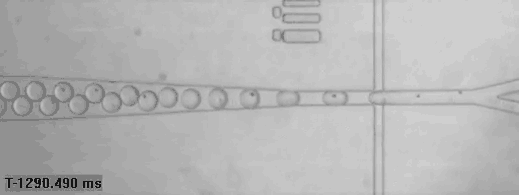/ News

Can We Identify Every Kind of Cell in the Body?

A microfluidic device (at center) can carry out experiments on individual cells.
How many types of cells are there in the human body? Textbooks say a couple of hundred. But the true number is undoubtedly far larger.
Piece by piece, a new, more detailed catalogue of cell types is emerging from labs like that of Aviv Regev at the Broad Institute, in Cambridge, Massachusetts, which are applying recent advances in single-cell genomics to study individual cells at a speed and scale previously unthinkable.
The technology applied at the Broad uses fluidic systems to separate cells on microscopic conveyor belts and then submits them to detailed genetic analysis, at the rate of thousands per day. Scientists expect such technologies to find use in medical applications where small differences between cells have big consequences, including cell-based drug screens, stem-cell research, cancer treatment, and basic studies of how tissues develop.
Regev says she has been working with the new methods to classify cells in mouse retinas and human brain tumors, and she is finding cell types never seen before. “We don’t really know what we’re made of,” she says.
Other labs are racing to produce their own surveys and improve the underlying technology. Today a team led by Stephen Quake of Stanford University published its own survey of 466 individual brain cells, calling it “a first step” toward a comprehensive cellular atlas of the human brain.
Such surveys have only recently become possible, scientists say. “A couple of years ago, the challenge was to get any useful data from single cells,” says Sten Linnarsson, a single-cell biologist at the Karolinska Institute in Stockholm, Sweden. In March, Linnarsson’s group used the new techniques to map several thousand cells from a mouse’s brain, identifying 47 kinds, including some subtypes never seen before.
Historically, the best way to study a single cell was to look at it through a microscope. In cancer hospitals, that’s how pathologists decide if cells are cancerous or not: they stain them with dyes, some first introduced in the early 1900s, and consider their location and appearance. Current methods distinguish about 300 different types, says Richard Conroy, a research official at the National Institutes of Health.
Individual cells are captured and separated in bubbles of liquid, readying them for analysis.

The new technology works instead by cataloguing messenger RNA molecules inside a cell. These messages are the genetic material the nucleus sends out to make proteins. Linnarsson’s method attaches a unique molecular bar code to every RNA molecule in each cell. The result is a gene expression profile, amounting to a fingerprint of a cell that reflects its molecular activity rather than what it looks like.
“Previously, cells were defined by one or two markers,” says Linnarsson. “Now we can say what is the full complement of genes expressed in those cells.”
Although researchers determined how to accurately sequence RNA from a single cell a few years ago, it’s only more recently that clever innovations in chemistry and microfluidics have led to an explosion of data. A California company, Cellular Research, showed this year that it could sort cells into micro-wells and then measure the RNA of 3,000 separate cells at once, at the cost of few pennies a cell.
Scientists think the new single-cell methods could overturn previous research findings. That is because previous gene expression studies were based on tissue samples or blood specimens containing thousands, even millions, of cells. Studying such blended mixtures meant researchers were seeing averages, says Eric Lander, head of the Broad Institute.
“Single-cell genomics has come of age in an unbelievable way in just the last 18 months,” Lander told an audience at the National Institutes of Health this year. “And once you realize we are at the point of doing individual cells, how could you ever put up with a fruit smoothie? It is just nuts to be doing genomics on smoothies.”
Lander, one of the leaders of the Human Genome Project, says it may be time to turn pilot projects like those Regev is leading into a wider effort to create a definitive atlas—one cataloguing all human cell types by gene activity and tracking them from the embryo all the way to adulthood.
“It’s a little premature to declare a national or international project until there’s been more piloting, but I think it’s an idea that’s very much in the air,” Lander said in a phone interview. “I think [in two years] we’re going to be in the position where it would be crazy not to have this information. If we had a periodic table of the cells, we would be able to figure out, so to speak, the atomic composition of any given sample.”
Gene profiles might eventually be combined with other efforts to study single cells. Paul Allen, Microsoft’s cofounder, said last December he would be spending $100 million to create a new scientific institute, the Allen Institute for Cell Science. It will study stem cells and video their behavior under microscopes as they develop into various cell types, with the ultimate goal of creating a massive animated model. Rick Horwitz, who leads that effort, says that it will serve as a kind of Google Earth for exploring a cell’s life cycle.
The eventual payoff of collecting all this data, says Garry Nolan, an immunologist at Stanford University, won’t be just a catalogue of cell types, but a deeper understanding of how cells work together. “The single-cell approach is a way station that needs to be understood on the way to understanding the greater system,” he says. “In 50 years, we’ll probably be measuring every molecule in the cell dynamically.”
Source: http://www.technologyreview.com/news/537416/single-cells-analyzed-at-unprecedented-scale/
/ About us
Founded by Russian entrepreneur Dmitry Itskov in February 2011 with the participation of leading Russian specialists in the field of neural interfaces, robotics, artificial organs and systems.
The main goals of the 2045 Initiative: the creation and realization of a new strategy for the development of humanity which meets global civilization challenges; the creation of optimale conditions promoting the spiritual enlightenment of humanity; and the realization of a new futuristic reality based on 5 principles: high spirituality, high culture, high ethics, high science and high technologies.
The main science mega-project of the 2045 Initiative aims to create technologies enabling the transfer of a individual’s personality to a more advanced non-biological carrier, and extending life, including to the point of immortality. We devote particular attention to enabling the fullest possible dialogue between the world’s major spiritual traditions, science and society.
A large-scale transformation of humanity, comparable to some of the major spiritual and sci-tech revolutions in history, will require a new strategy. We believe this to be necessary to overcome existing crises, which threaten our planetary habitat and the continued existence of humanity as a species. With the 2045 Initiative, we hope to realize a new strategy for humanity's development, and in so doing, create a more productive, fulfilling, and satisfying future.
The "2045" team is working towards creating an international research center where leading scientists will be engaged in research and development in the fields of anthropomorphic robotics, living systems modeling and brain and consciousness modeling with the goal of transferring one’s individual consciousness to an artificial carrier and achieving cybernetic immortality.
An annual congress "The Global Future 2045" is organized by the Initiative to give platform for discussing mankind's evolutionary strategy based on technologies of cybernetic immortality as well as the possible impact of such technologies on global society, politics and economies of the future.
Future prospects of "2045" Initiative for society
2015-2020
The emergence and widespread use of affordable android "avatars" controlled by a "brain-computer" interface. Coupled with related technologies “avatars’ will give people a number of new features: ability to work in dangerous environments, perform rescue operations, travel in extreme situations etc.
Avatar components will be used in medicine for the rehabilitation of fully or partially disabled patients giving them prosthetic limbs or recover lost senses.
2020-2025
Creation of an autonomous life-support system for the human brain linked to a robot, ‘avatar’, will save people whose body is completely worn out or irreversibly damaged. Any patient with an intact brain will be able to return to a fully functioning bodily life. Such technologies will greatly enlarge the possibility of hybrid bio-electronic devices, thus creating a new IT revolution and will make all kinds of superimpositions of electronic and biological systems possible.
2030-2035
Creation of a computer model of the brain and human consciousness with the subsequent development of means to transfer individual consciousness onto an artificial carrier. This development will profoundly change the world, it will not only give everyone the possibility of cybernetic immortality but will also create a friendly artificial intelligence, expand human capabilities and provide opportunities for ordinary people to restore or modify their own brain multiple times. The final result at this stage can be a real revolution in the understanding of human nature that will completely change the human and technical prospects for humanity.
2045
This is the time when substance-independent minds will receive new bodies with capacities far exceeding those of ordinary humans. A new era for humanity will arrive! Changes will occur in all spheres of human activity – energy generation, transportation, politics, medicine, psychology, sciences, and so on.
Today it is hard to imagine a future when bodies consisting of nanorobots will become affordable and capable of taking any form. It is also hard to imagine body holograms featuring controlled matter. One thing is clear however: humanity, for the first time in its history, will make a fully managed evolutionary transition and eventually become a new species. Moreover, prerequisites for a large-scale expansion into outer space will be created as well.
Key elements of the project in the future
• International social movement
• social network immortal.me
• charitable foundation "Global Future 2045" (Foundation 2045)
• scientific research centre "Immortality"
• business incubator
• University of "Immortality"
• annual award for contribution to the realization of the project of "Immortality”.



 LinkedIn
LinkedIn
 LiveJournal
LiveJournal
 Google
Google
 Twitter
Twitter
 Facebook
Facebook
 Я.ру
Я.ру
 ВКонтакте
ВКонтакте
 Mail.ru
Mail.ru